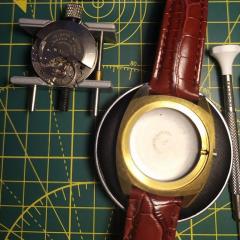Whats everybody's technique on oiling non-shock protected cap jewels
-
Recently Browsing
- No registered users viewing this page.
-
Topics
-
Posts
-
By watchweasol · Posted
As mentioned by the other members, it’s a dismantle job clean and inspect the solder joints. It’s an older generation using the paxolin pcb not the glass fiber ones. -
By watchweasol · Posted
Hi in regard to your questions, The springs should ideally removed from the barrel but to do this you need a mainspring winder that are quite expensive for a one off. Or you c a make your own see Google “ joes mainspring winder”. I have made two and they work well, you will also have to source some tube for the retainers. the gathering pallet cann be removed using levers ( mini crow bars) again I made my own no problem. the case can be glued using evostick wood glue but bind the case together to close the crack. When solid you can use wax sticks (used for furniture) melted and rubbed in to cover any blemish left. best to clean the case and then use bees wax to polish, a bit of elbow grease needed do not clean the dial with anything other than warm water and a couple of drops of mild soap. Try on an inconspicuous part first. There is a product called MILIPUTTY in various colours on eBay that can be used on cracked enamel dials depending on how bad it is . -
By RichardHarris123 · Posted
I was wondering because of the alum idea. -
just a reminder about this test is it's not a perfect test it's a quick test. In other words you can adjust the banking pins that are both the same and visually this test will pass everything looks the same but both banking pins can be in the wrong place. although the majority of time when people are playing with banking pins I don't put them in the same place. one of things have to be careful of is I believe some of the pallet fork measuring tools that actually give you the roller jewel size are actually size so that I get confused? What I mean by this is if you inserted a whatever size in and are always told to go a slightly smaller I thought that the gauge itself its number corresponded to give you the exact number. So a lot of it depends upon the gauge itself I think you do want the roller jewel slightly smaller because it does have to fit in the slot and it does have a little bit a play. But if it's too small you will lose energy so does have to be sized right. Oh other things to check is? I'm attaching an Elgin sheet on checking the escapement I've seen references in the past to making sure that the slot in the four corn is nice and smooth and apparently you can end up with a rough slot and then the recommendation is to polisher clean that up. Not sure how well that's really going to work even if it has been the recommendation of other reference materials. yes art full plate watches fun when they don't work. This is where it's nice to have another set of eyes sometimes as maybe they'll find something you didn't although that can add other issues. The owner of the shop provides himself on his skills of so now two of my watches have relocated to his bench to solve problems both real and imaginary I'm sure that will get fixed eventually hopefully. But still sometimes another set of eyes might see something that you're not. yes this sort of thing can be quite frustrating. Also makes for an interesting problem unless of course you're the one trying to solve the problem that it's a Escapement Elgin setting up the escapement.PDF
-
I’m not to sure mate! I’ve sent a picture! The crown is off a Tissot 1853 automatic limited edition T115427 A GP19 moto go watch!
-






Recommended Posts
Join the conversation
You can post now and register later. If you have an account, sign in now to post with your account.
Note: Your post will require moderator approval before it will be visible.